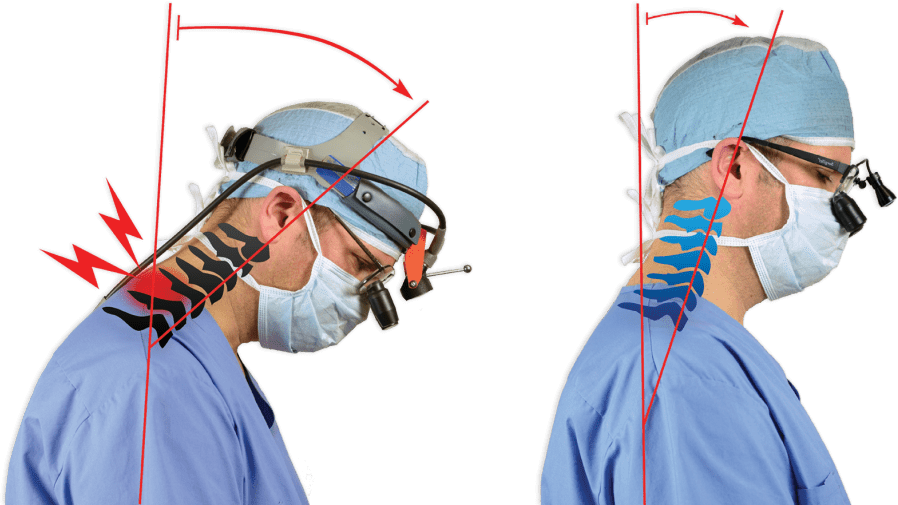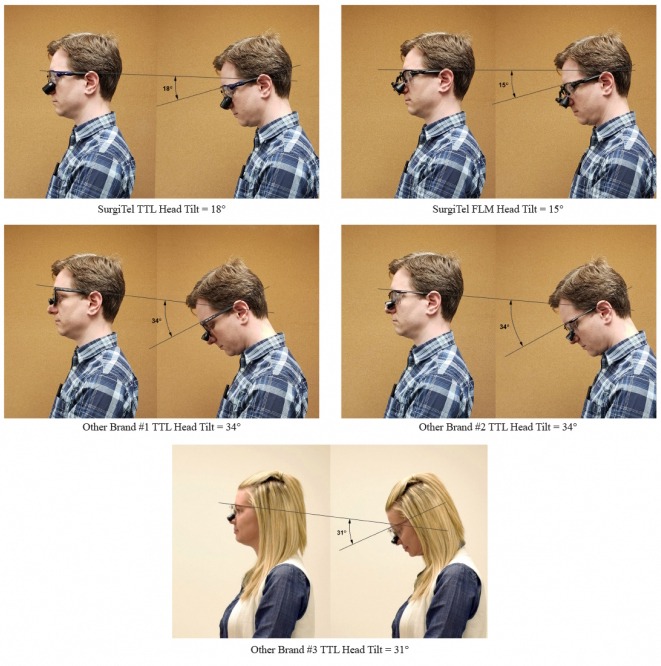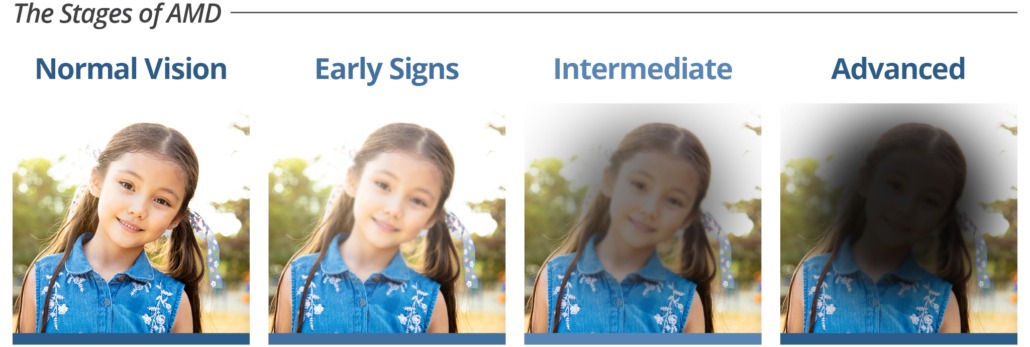The Hidden Cost of Non-Ergonomic Loupes and Cool/Blue-Tinted LED Headlights
 ErgoPractice News – March 2021
ErgoPractice News – March 2021
By Jin Chang PhD
jchang@surgitel.com
Loupes and LED headlights have become essential for the practice of dentistry and surgery, but they can be detrimental to the health of users if not made properly. Improperly fitted loupes can cause chronic pain in neck and upper shoulders1 and the strong blue light of cool/blue-tinted LED headlights can be a cause of early-onset, age-related macular degeneration (AMD).2 But most loupes on the marketing are non-ergonomic designs and most LED headlights are not VisionSafe™. This is despite all companies’ marketing messages claiming the opposite.
The Hidden Cost of Non-Ergonomic Loupes
Since non-ergonomic loupes are the main cause of chronic pain among both dental professionals and surgeons, let’s think about the hidden cost of non-ergonomic loupes. Dr. Bethany Valachi estimated “The Hidden Cost of Pain in Dentistry” as a part of her “The Valachi WellBody System for dental professionals (evidence-based video training series),”3 the minimum cost of $20,000 to $50,000 for dentists and $9,000 to $30,000 for hygienists which only considered “purchasing non-ergonomic loupes & stools” and “sick leave of 6+ weeks.” The hidden cost can be far higher if we expand consideration to factors such as medical bills, decreased production, decreased value of practice, chiropractic & doctor’s appointments, premature retirements/disability, and quality of life issues.
To avoid these hidden costs clinicians should use true ergonomic loupes.
How Can Clinicians Be Sure They Are Buying Ergonomic Loupes?

Figure 1 – Dangerous Neck Tilt (Left), Comfortable Neck Tilt (Right)
Ergonomic loupes should be custom-built for each clinician so that the clinician can maintain a forward head tilt of less than 20 degrees. Figure 1 shows good and poor working postures wearing loupes. A greater forward head tilt is unstainable for the average human body and causes pain, eventual injury.1
Many companies claim large declination angles by using their own way of measurement. There is no standard measurement method that companies must adhere to and thus companies often just claim whatever numbers they feel will sell best. It is very difficult for clinicians to estimate true declination angle. The best way to determine that your loupes are ergonomically made for you is to measure what your head tilt is when you work with your loupes. The salesperson may claim the best declination angle, but if your head tilt is greater than 20 degrees, you are at risk of incurring the hidden costs.
You can measure your head tilt angle with the “two-photo” method (https://www.surgitel.com/true-ergonomics-from-surgitel-the-truth-about-declination-angle).4 Note that these photos may include a vertical reference object for the easy arrangement of two photos. Figure 2 shows how to use two side view photos to find head tilt angles. If you need help with this, you may contact me directly at jchang@surgitel.com. You should do this with your current loupes if you want to avoid chronic pain. If you purchase a new pair of loupes, you should do this during the loupe’s trial period so that if the head tilt is more than 20 degrees, you can ask the manufacturer to remake your loupes so that you can work with a safe head tilt of less than 20 degrees forward. If the company cannot meet that requirement, you should return your loupes and find another manufacturer which can make ergonomic loupes. Note that SurgiTel can make ergonomic PostureSafe™ loupes for all clinicians with all types of facial features by using patented designs and patented manufacturing technologies.

Figure 2 – Neck Tilt Comparisons and Measurements
The Hidden Cost of Cool/Blue-Tinted LED Headlights with Strong Blue Spectral Light
Third-party research shows most LED headlights used by clinicians are extreme cool LED lights whose color temperature (CT) is 6,000K to 10,000K. The color temperature of SurgiTel’s VisionSafe™ neutral/natural LED headlights is 4,000K. SurgiTel’s neutral LED lights is proven to offer the best color accuracy and the safest to eyes.5,6 It is noted that the blue spectrum of these cool LED lights is the same blue light that is used by curing lights. All clinicians know their eyes should be protected from curing lights, but they look directly at cool/blue-tinted LED lights with strong blue light, and even focus and concentrate the light into their eyes by using magnification loupes.7
Extreme blue lights distort the image color of objects and strain our eyes because our eyes have trouble reacting appropriately to close the iris and thus cannot effectively limit the blue light exposed to the retina.8 Blue-tinted light also causes difficulty with cosmetic work. And worst of all, extended exposure to the blue light from cool LED lights can cause early-onset age-related macular degeneration (AMD) and loss of vision resulting in early retirement or even disability.2 Figure 3 shows vision with healthy eyes and vision with eyes with AMD.

Figure 3 – Stages of AMD: Normal Vision (Left), Early Signs to Intermediate (Center), Advanced AMD (Right)
To avoid these hidden costs clinicians should use VisionSafe™ LED headlights.
How Can Clinicians Buy VisionSafe™ LED Headlights?
Cool/blue-tinted LED lights often seem fine when used in isolation, but differences become apparent when shown directly next to neutral/natural LED lights.9 VisionSafe™ neutral/natural LED lights offer the best color accuracy and are the safest to the eyes. Since eyes cannot measure the color temperature of LED lights, the best way to determine that your LED headlights are safe to your eyes is to compare your current LED lights with a VisionSafe™ neutral/natural LED headlight. Note that some LED lights sold as neutral LED lights are not true neutral LED lights. SurgiTel offers a Free Evaluation of your LED headlights by comparing your LED headlights with SurgiTel’s VisionSafe™ neutral LED headlights.
SurgiTel’s Free Evaluation Service
SurgiTel offers free evaluation services to help clinicians evaluate their loupes and LED headlights. There are two main services we offer. The first service is to evaluate loupes & headlights and the second service is an educational seminar that helps clinicians understand basic issues related to loupes and LED headlights. For a personal evaluation of our products, submit the form below or contact us at www.SurgiTel.com/MyRep, and for seminar scheduling please contact me directly at jchang@surgitel.com.
References:
- Valachi, Bethany. Practice Dentistry Pain-Free. Portland, Oregon: Posturedontics Press, 2008. https://posturedontics.com/
- French Agency for Food, Environmental and Occupational Health & Safety, 2019. On The “Effects on Human Health and The Environment (Fauna And Flora) of Systems Using Light-Emitting Diodes (Leds)”. Available at: https://www.anses.fr/en/system/files/AP2014SA0253EN.pdf [Accessed 28 August 2020].
- Valachi, Bethany, The Dental Ergonomic WellBody System by Dr. Valachi (posturedontics.com)
- Chang, BJ, The Truth about Declination Angle, ErgoPractice News, June 2020, go to: True Ergonomics from SurgiTel: The Truth about Declination Angle
- An independent, non-profit dental education and product testing foundation, Clinicians Report, August 2016. For the full report, go to: www.surgitel.com/CR
- An independent, non-profit dental education and product testing foundation, Clinicians Report, May 2017. For the full report, go to: www.surgitel.com/CR
- Price, R., The Blue Light Hazard in Medicine and Dentistry, June 2012, go to: The Blue Light Hazard in Medicine and Dentistry – YouTube
- Chang, BJ, Is Your LED Headlight Type Safe for Your Eyes, ErgoPractice News, November 2018, go to: Is Your LED Headlight Type Safe for Your Eyes? | SurgiTel
- Chang, BJ., Evaluation of Major Brands LED Headlights, ErgoPractice News, August 2020, go to: SurgiTel | Evaluation of major brands of LED Headlights



